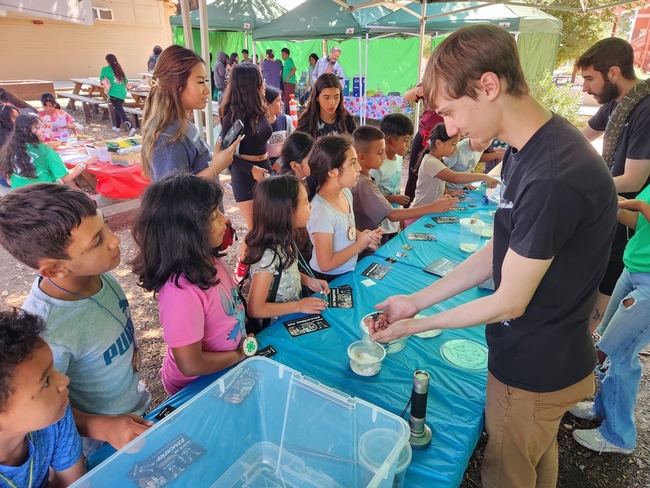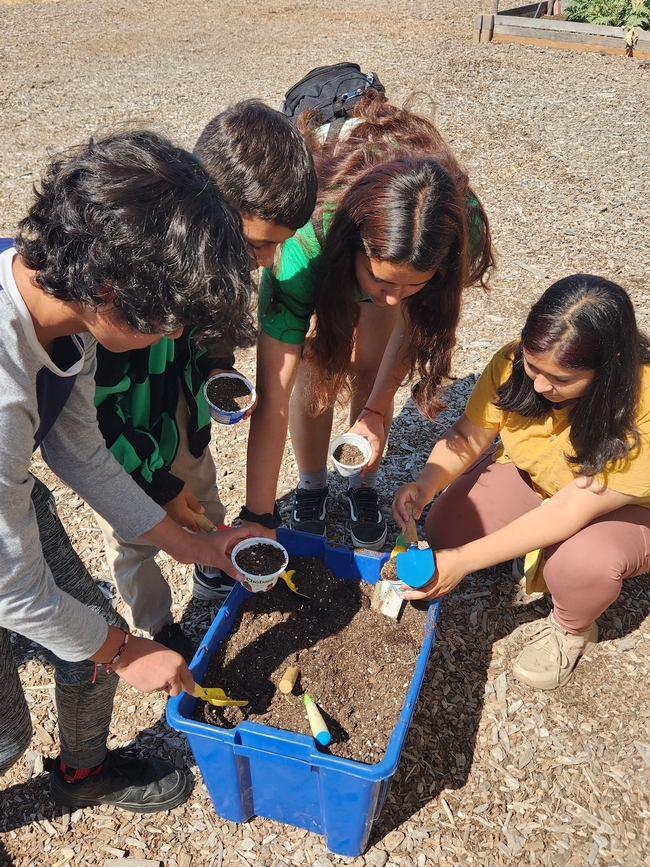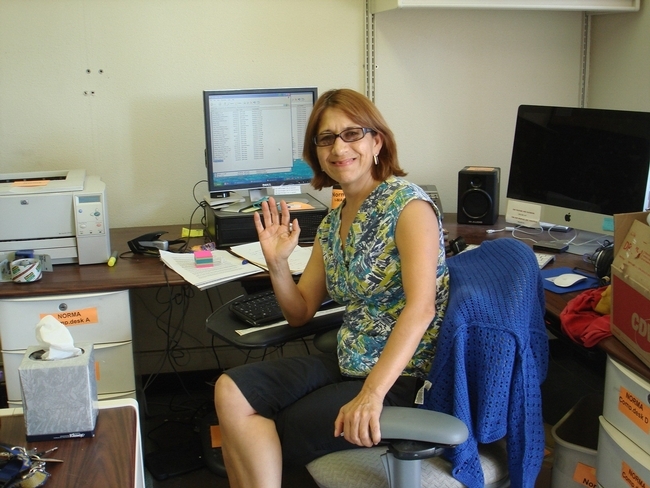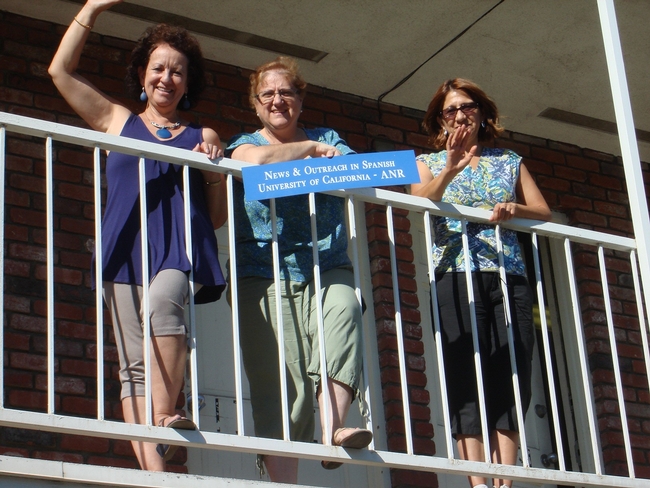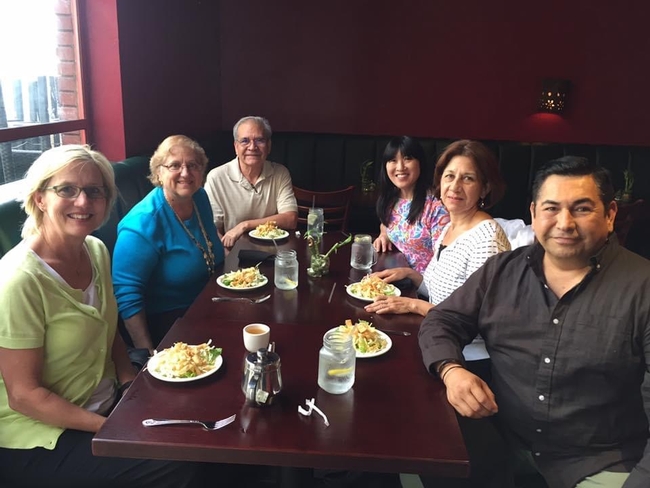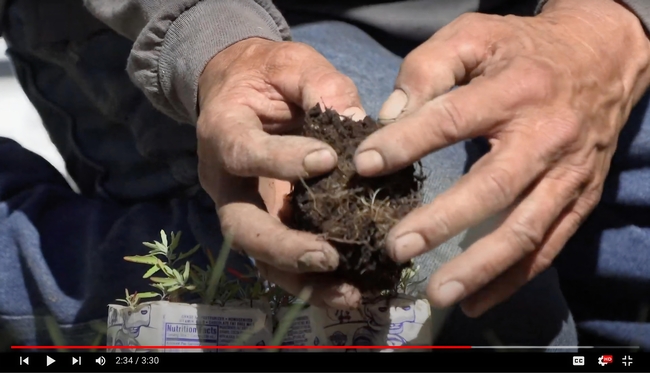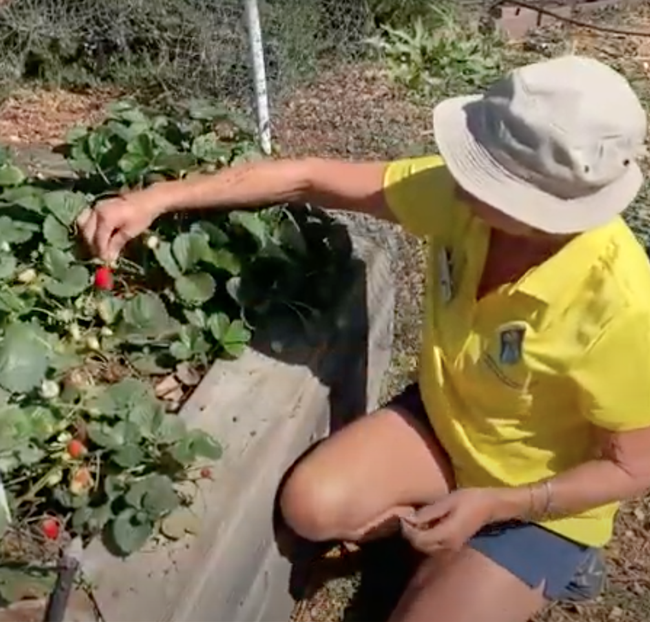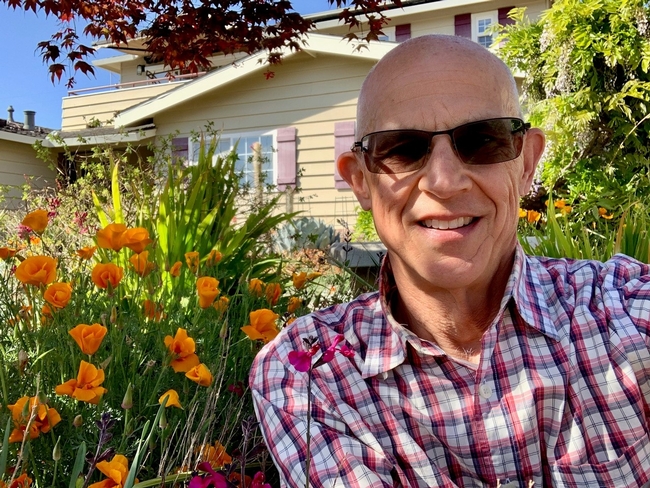Posts Tagged: Spanish
Latino students shine (and squeal) at 4-H Nature Explorers Day Camp
University of California Cooperative Extension, 4-H Youth Development Program in Santa Clara County partnered with multiple community organizations to hold a 4-H Nature Explorers Day Camp at Escuela Popular Bilingual Academy in East San Jose from July 17 to July 21.
Organizers wanted to reach more participants this year than they had in the inaugural 2022 camp, so they structured the program for different K-8 grade levels to attend on different days. 79 campers participated, which was a 130% increase over the number of campers last year.
“Everything we did during the week was focused on environmental science,” said Susan Weaver, 4-H Regional Program Coordinator. “We partnered with Project Learning Tree, UC Environmental Stewards, UC Master Gardeners and CalFresh Healthy Living, UC– as well as community agencies related to the natural environment.”
Numerous activities engaged the youths such as field trips; demonstrations; and sessions themed around trees as habitats, birds and bugs, and being “leaf detectives.” 4-H Adult Volunteer, Laura Tiscareno, took charge of the hands-on Project Learning Tree sessions. Craft time included making nature-themed wind chimes and spinning paper snakes.
Bilingual teen camp counselors guided small groups of students for the duration of the day camp. In situations where the adult facilitator did not speak Spanish, teens translated information into Spanish for students with less English confidence.
“These kids call me ‘teacher' and it's awesome,” said Rodrigo, one of the counselors. “The camp benefits me a lot because I connect with children and in the future, I can even be a teacher if I wanted to.”
Another counselor, Andrea, learned about communication. “It's a bit different with kids at different age levels,” she said. “Since we had kindergarten through eighth grade, we had to switch our tactics from grade to grade so that they would understand us and we'd be able to understand them. Also learning how to bond with them so that they would pay more attention.
One highlight of the week was a field trip for third through eighth graders to the Master Gardeners location at Martial Cottle Park, where students learned about vermicomposting and made their own individual countertop worm habitat and composter.
Campers especially enjoyed the interactive demonstrations. “My favorite part is going on all the field trips because we went to a garden, and we've been catching worms and doing stuff about worms,” said one student. “It's really fun going on trips.”
Another camper said, “Something I would like to change about camp is having more time here.”
The program culminated in a Nature Camp Festival at Escuela Popular in partnership with community agencies. Youth enjoyed games, meeting reptiles, outdoor science activities, arborist crafts, a “Rethink Your Drink” table to make a fresh fruit drink, tamales, a nacho bar and more.
Representatives from the Silicon Valley Wildlife Center discussed animals that live in local neighborhoods and how the Center supports people to keep the animals safe. Victor Mortari of Vexotic Me talked about and showed snakes, spiders, scorpions, and other creatures, making the kids squeal while learning about them. As a fun added bonus, 4-H Community Educator Zubia Mahmood arranged to have a local team come to teach soccer skills as a healthy living activity.
The event increased the youth's interest in environmental education and involved Latino youth and adults who are new to 4-H – representing a community that has not historically benefited from the 4-H program. The teen teachers also increased their leadership and career readiness skills; post-camp surveys showed that all the teen counselors see 4-H as a place where they can be a leader and help make group decisions. Some campers noted in the survey that they wanted the camp to be every day, all summer!
National 4-H funded the camp in 2022 and 2023, allowing organizers to provide meals, T-shirts, water bottles and other items to foster belonging and promote healthy living. Community partners, crucial to the program's success, included the Boys and Girls Club of Silicon Valley, Escuela Popular Bilingual Academy, Silicon Valley Water and Silicon Valley Wildlife Center.

Teen counselors and campers working on a nutrition activity.
Norma De la Vega retires as broadcast communications specialist after 13 years
After 13 years of telling the UC ANR story through written articles and video production, Norma De la Vega retired on June 29. De la Vega joined UC ANR's News and Information Outreach in Spanish team in 2009 as a senior writer.
NOS fulfilled UC ANR's vision of developing educational and informational programs in Spanish to serve the Latino community. For more than 40 years, NOS has been producing information formatted for radio, television, and online audiences, and De la Vega has played an instrumental role in helping NOS expand its reach and diversify its creative approach to storytelling.
When she started, most of her writing focused on nutrition, highlighting groups like the Expanded Food and Nutrition Education Program and the Nutrition Policy Institute. “Norma's contributions were spot on,” said NOS Program Manager Ricardo Vela. “Her impact has been bringing the importance of nutrition into the stories that we bring to the community.”
De la Vega earned a bachelor's degree in science communications from Universidad Nacional Autónoma de México in her hometown of Mexico City. “Learning how to produce videos when I went to school was very different than now,” said De la Vega. “We didn't have the kind of cameras we do today.”
Following college, De la Vega worked as a television reporter in Tijuana before moving to San Diego County where she started focusing on writing. Prior to UC ANR, De La Vega worked as a writer for the Enlace Union-Tribune's Spanish newspaper in San Diego for nearly a decade.
Before it became NOS' primary medium for storytelling, De la Vega helped lead the team's video production effort despite her limited experience. “We weren't experts, but we realized the importance of video production to get our information out. It was a team effort,” she said.
In 2010, De la Vega wrote a story and produced a video on the importance of planning for old age. In many cases, adult children had to manage their parent's care without guidance, and most caregivers of the elderly spoke Spanish as their first language and needed more resources to do a better job.
De la Vega's story relied on research conducted by Patti Wooten Swanson, UCCE nutrition, family and consumer science advisor in San Diego. Not only was Swanson honored at the 2013 Galaxy Awards for her contribution to the story, but De la Vega, a member of the NOS team at the time, won first place at the Western Region Television/Video Communications Award Ceremony despite the lack of a Spanish language category.
In 2016, De la Vega produced a video of the first bilingual 4-H club, the result of a partnership with the Community Settlement Association in Riverside County. “A lot of good things were happening at that time and are happening now because ANR is evolving with more bilingual experts on different topics,” De la Vega said.
Although she started as a senior writer, De La Vega evolved and became a broadcast communications specialist. Her success in the role allowed her to become well-connected to other communicators and community leaders. “Norma always had a contact we needed for a story that we were working on,” said Miguel Sanchez, another broadcast communications specialist on the NOS team.
Lisa Rawleigh, NOS administrative assistant, established a personal and professional relationship with De la Vega. “Norma ensured that our Spanish articles were written properly and that we did not miss any accents or typos. I can always count on her to proofread my posts on social media,” said Rawleigh.
De la Vega said that she feels “enormously satisfied” to have worked with a team of fellow pioneers. “Although we were not experts, we learned so much every day and together,” De la Vega said. “Today, there are several experts in the production of community videos, and we helped enrich the graphic archive for UC ANR's community programs. I think our contribution was to lead the way in that direction.”
Looking ahead, De la Vega will be spending her retirement traveling and exploring other countries and cultures. Since she was a girl, De la Vega enjoyed swimming and can't wait to do more of it. “I love to swim because being in the water always makes me feel young,” she said.
Finally, De la Vega will enjoy quality time with her grandchildren, teaching them Spanish and volunteering at the Spanish immersion school they attend.
To read this story in Spanish, visit https://ucanr.edu/blogs/blogcore/postdetail.cfm?postnum=57440.
Master Gardeners go digital, cultivate community online
When stay-at-home orders went into place in March 2020, many of us took up newfound pastimes and reprioritized the tasks that filled our days. It wasn't all about baking sourdough bread and fulfilling TikTok challenges - the pandemic also ushered in a new wave of novice gardeners looking for help and advice on how to delve into home horticulture.
The perfect group to aid in this mission was the UC Master Gardeners, a program that has focused on sharing research-based information about gardening and pest management with the public since 1980. At the start of the pandemic, Master Gardeners were suddenly bombarded with a higher volume of calls and emails seeking gardening advice. This public service and outreach program under the University of California Agriculture and Natural Resources (UCANR) is usually administered in person by participating UC Cooperative Extension county offices, but COVID forced Master Gardeners to rethink their strategy for disseminating critical horticulture resources. Volunteers across the state showed continued to extend information by using new digital platforms and technology, efforts that have helped the program stay connected to California communities.
Gardening resources in Spanish
One significant digital resource developed by Master Gardeners during the pandemic has been the addition of gardening videos in Spanish. The majority of resources offered through the program are only in English. But according to the 2019 census data, the most common non-English language spoken in California is Spanish; 28.8% of the overall population are native Spanish speakers. An internal UC ANR grant to develop online educational resource materials in other languages proved to be the perfect opportunity to expand gardening resources for Spanish speakers.
With a spirit of collaboration, Master Gardener volunteers, local community organizations and partners, and UC News and Outreach in Spanish staff created and released a series of food gardening videos in Spanish. In addition, they are working on translating the entire California Master Gardener Handbook (the chapter dedicated to food gardening is already completed).
Visit the statewide UC Master Gardener YouTube channel at youtube.com/c/UCMasterGardenerProgram to access the playlist of videos in Spanish. These videos are available for sharing on social media, websites, or anywhere the program reaches the gardening public.
Digital Superstars
The Spanish translation project has provided aid to countless community members looking to start gardens during the pandemic, but hope and resilience during COVID-19 are arguably even better exemplified through individual volunteers who have spearheaded digital initiatives through the Master Gardener Program. Some volunteers stand out as digital superstars.
Allen Buchinski joined the program in 2003 with a love of gardening and its sense of community. Buchinski has played an instrumental role in developing and maintaining the UC Master Gardener Program of Santa Clara County's website (mgsantaclara.ucanr.edu). He aided in bringing the program's help desk online, and he also coded an online storefront for selling seedlings and scheduling pick-ups.
“The help desk has been especially interesting during the past year because of the pandemic,” says Buchinski. “We needed to adjust our processes to work from home as well as deal with a 50% increase in the number of questions. We answered more than 2,100 questions from March 2020 to February 2021!”
While Buchinski's expertise focuses on web development, digital communication also relies on social media. Social media expert Michele Willer-Allred joined the UC Master Gardener Program of Ventura County in 2020 and became co-chair of the communications committee shortly after.
“Social media has been a great tool, especially with promoting our virtual workshops and interacting with other Master Gardeners throughout the country. But there is so much more we want to do,” explains Willer-Allred. “We plan to start an email newsletter; create educational gardening videos and virtual tours of local gardens; profile more of our amazing garden volunteers; and go outside our county and visit with other UC Master Gardener Programs. We also hope to increase our reach to a broader, more ethnically diverse audience, as well as younger gardeners in our community, since they are indeed our future!"
Long-time volunteer Rita Evans has been an active UC Master Gardener volunteer in Fresno County since 1993. When the pandemic hit, the county office closed, and most volunteer activities ceased. Evans immediately came up with a plan for how volunteers could stay connected and continue to earn hours.
“When the pandemic hit, our online refresher course was born. It is a 16-session 'refresher' using the UC Master Gardener Handbook with our own UC Master Gardener volunteers being the featured speakers,” explains Evans. “It is providing a path for volunteers to earn their required hours, to socialize virtually with a study buddy, and to refresh their horticulture knowledge ... it's a win-win.”
Buchinski, Willer-Allred and Evans are a few digital superstars shining among many volunteers who have given countless hours toward increasing access to gardening resources for communities across the state. Their efforts, in addition to the Spanish translation team, are true stories of hope and resilience during this pandemic and represent the beginning of a new era of increased access to resources.
Beautiful but ecologically harmful shrubs get a foothold in California forests

Scotch, Spanish and French broom were introduced from Europe in the mid-1800s as lovely, easy-to-grow garden accents and land stabilizers, but they have become aggressive invaders threatening native plants and increasing fire hazards.
“These brooms crowd out our native flora and form large, dense stands of just broom,” said Scott Oneto, UC Cooperative Extension advisor in the Central Sierra. “It’s also displacing the birds and animals that would live in this environment with native plants.”
The characteristics of invasive brooms cause several problems. The plants grow large and upright, developing thick trunks at the base. After its relatively short life span - typically 7 to 8 years, 15 at the most – they die and become tinder-dry woody skeletons that can burn high and hot.
The brooms are also a member of the legume family. Legumes are unique in the plant world. They have evolved a symbiotic relationship with bacteria that live on their roots. The bacteria are able to pull nitrogen from the atmosphere and deposit it into the soil, where it feeds the plant.
“These soils are naturally very low in nitrogen,” Oneto said. “Our native plants thrive in low-nitrogen soils. Large populations of broom are changing the soil chemistry so even after they are removed, the area is no longer ideal for our native vegetation.”
Large stands of broom are also a significant concern for rangeland managers. Cows don’t like the taste; only goats will eat it. When the plant is grazed off or cut back, it readily re-sprouts from the crown. The plant’s spread is bolstered by its intriguing ability to scatter seeds widely. Brooms grow seed pods that are naturally spring loaded. When the seeds are ready for dispersal, they fling from the pod with the force of a tiny explosion.
In collaboration with the non-profit California Invasive Plant Council, which received a grant from the Sierra Nevada Conservancy, Oneto is working to eradicate broom from a particularly sensitive location. Highway 120, for many the “gateway to Yosemite,” has populations of French and Spanish broom.
“We’ve started by mapping the broom along Highway 120 and plan to eliminate the population to prevent it from moving further into the forest and eventually into Yosemite National Park,” Oneto said.
The grant is providing the funding for environmental and regulatory compliance so that control measures can be implemented.
“Once the regulatory compliance is complete, the project will be shovel-ready and we can begin treatment,” Oneto said.

“If broom is growing wild or as an ornamental on your property, we suggest you remove it and replace it with a non-invasive plant,” said Rebecca Miller-Cripps, natural resources program representative with UCCE Central Sierra. For example, forsythia produces yellow flowers and a shrub of about the same size and shape as brooms, but isn’t invasive, she said.
For more about invasive broom, see the video below:
*Ag in Uncertain Times* adds Spanish programming
A webinar series produced by an organization of agricultural economists at Western land-grant universities is adding Spanish programming this month, according to a news release distributed today by Washington State University. Webinars are seminars on the Web.
The webinar series in English, called "Ag in Uncertain Times," began broadcasting in June 2009. Past programs programs have included "Operating in risky environments" and "Operating in the face of uncertain markets." All programs are recorded and available on the Western Extension Committee Web site.
The first Spanish webinar, set for Wednesday, March 10, will address management of finances and credit in an agricultural setting. On March 17, participants will hear about business planning and market strategies and on March 24, strategies, tools and resources for selecting and diversifying crops. All sessions begin at 4 p.m. Pacific and can be accessed at http://www.msuextensionconnect.org/aginuncertaintimes/
The Spanish sessions will be presented by a bilingual team led by Ramiro Lobo, small farm program advisor for UC Cooperative Extension in San Diego County. Links to the recorded webinars will be posted on the Ag in Uncertain Times en español Web site after they are presented live.

Ag in Uncertain Times en español Web site.
